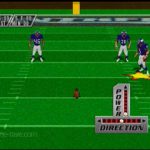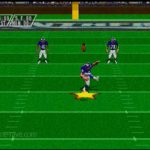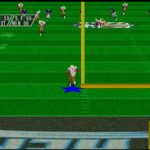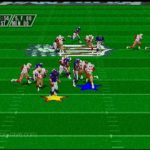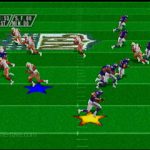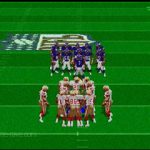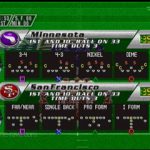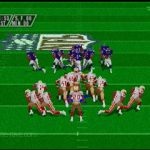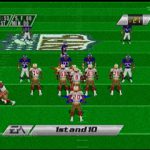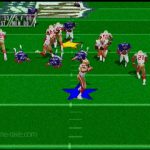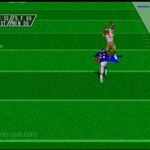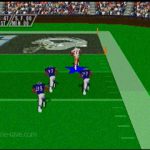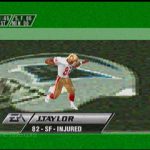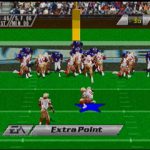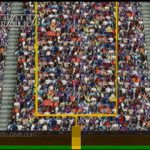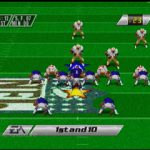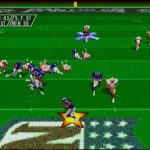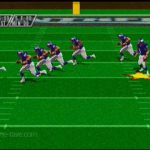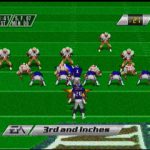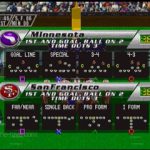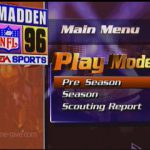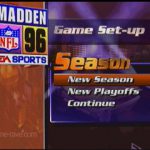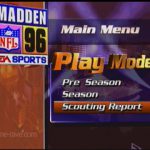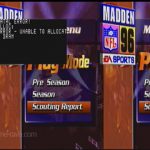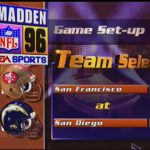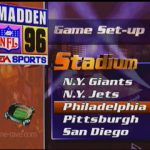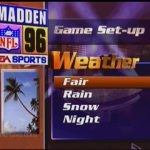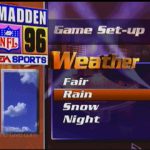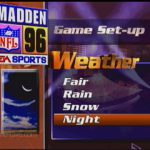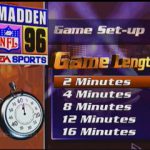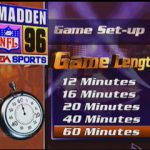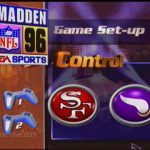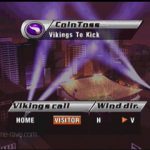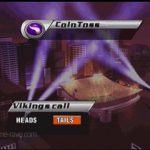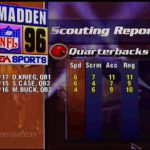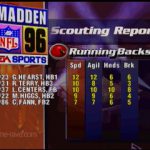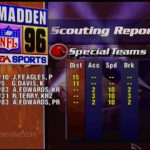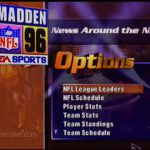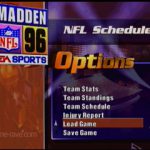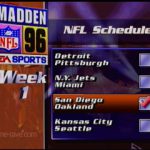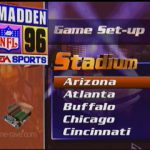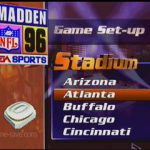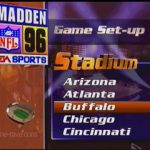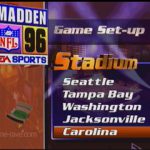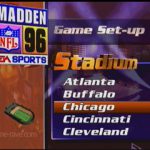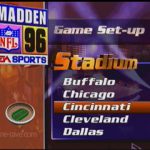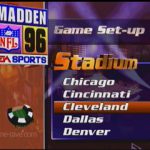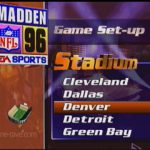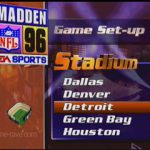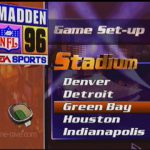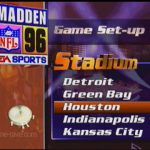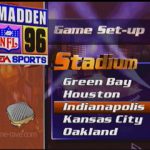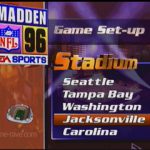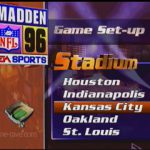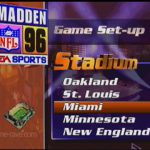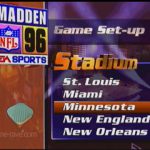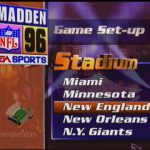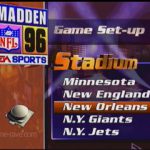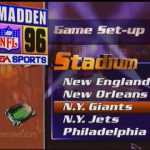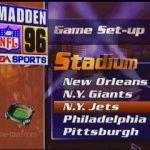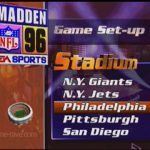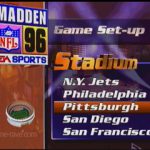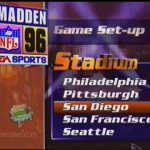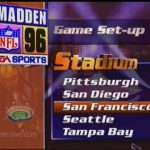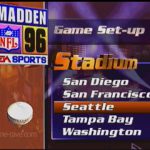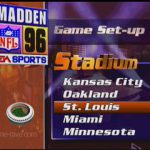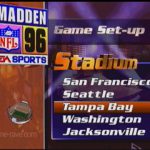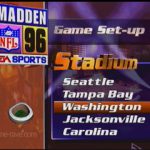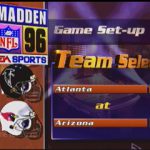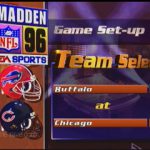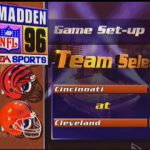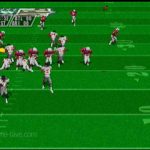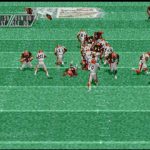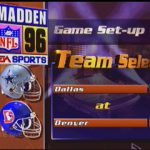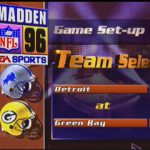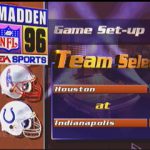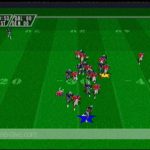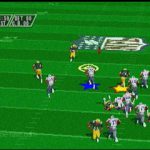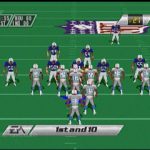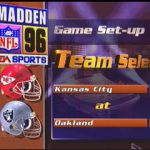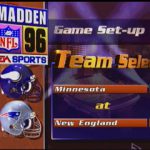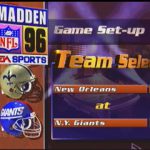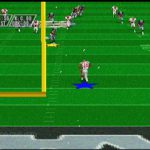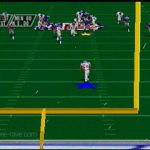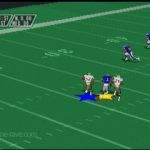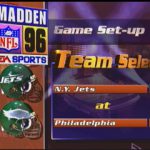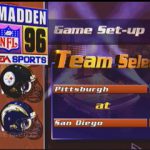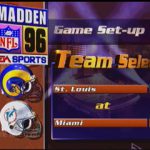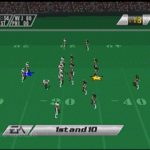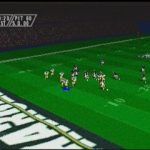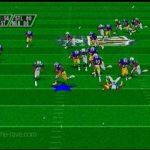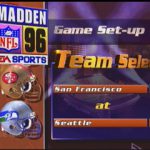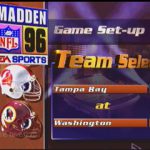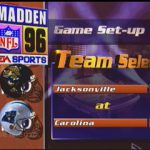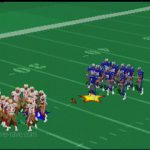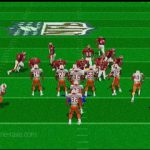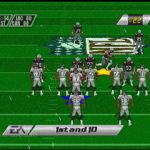Every so often Game-Rave.com takes a step outside the variants and long boxes to explore games that never made it to public hands, or at least in American gamers’ hands. Join in as Game-Rave explores legends and tales never told.
Overview and History
(Originally published August 30, 2012)
It’s a game report that had to be done, and it had to be done right. This was the biggest part of it – how to properly catalog and present every last nook and cranny of the cancellation heard around the world – Madden NFL ’96.
Madden NFL ’96, across all platforms, began life in November of 1995** according to the game’s producer Mike Rubinelli. Coming off a strong 16-bit year and heading into the title match between the 32-bit Sega Saturn, the PlayStation, and 3DO, EA knew they had to get software out at launch, and that had to include their flagship title.
In an interview with Dam Amrich of GameSport, Rubinelli discussed how at the time EA was taking fan mail to see if what the players wanted was matching up to what the designers had in mind. Admitting a 90% match ratio, the team felt they were on the right track to release on the new platforms. Said Rubinelli, “Give the user everything they expect, and then some. So it is with 32-bit as well; they expect the 3-D stuff, the big guys, cool digital audio, and beautiful graphics. So we give them all of that. The things that they don’t expect are logos on the helmets and authentic striping on the jerseys, the really big rendered touchdown animations, motion captured from professional players.” A second article claims that the game would have had “More than 100 teams…new features including General Manager.”
Among all those features, there would have also been various Full Motion Video (FMV) segments for the game that included both John Madden and Pat Summerall discussing the game, as well as John discussing play formations. An issue of Cyber Sports even had behind-the-scenes images of Madden being prepped for the photo shoot.
To understand the gravity of the situation, back in the day, Madden was the game. While modern gamers now bask in the Call of Duty franchise, in the early 90’s there was just Madden. Grown men called off work, tournaments were created, and hosted, real pro players got involved at every step, and more. I was in gaming retail and the industry for almost 20 years – I still remember when Madden ’97 hit, and I had lines of people waiting to just rent the damn thing at my workplace.
So where did it all go wrong? Various resources paint a pretty depressing and desperate picture of the production. Early on, there were problems right from the start. First and foremost, the initial image of the game on the back of the system box and the first demo disc is a ‘representation’ and not actual in-game footage. The game is nowhere on the demo disc, which always confused people, and was a clear sign something was up.
Two producers had left the game early on, which didn’t help the game’s frantically short development window. Second, EA was buried deep in 16-bit software releases and playing catch up with the new 32-Bit technology. To try and lighten the burden, Madden ’96 was to be outsourced from High Score to a smaller dev team that would get it done as fast as possible. That just happened to be a team from Visual Concepts.
Yes, that Visual Concepts.
The group’s biggest problem lay in how they were approaching the assets for the game, which while ambitious, proved to be one of the game’s downfalls. An anonymous source interviewed by EGM (Electronic Gaming Monthly) over a decade later would shed light on the specific details. “They tried to render each team individually,” he explained. “Instead of rendering a player, then applying different uniform textures, they painstakingly rendered the 49ers, the Cowboys, etc.” Simply put, each player render was adding to the workload of the PlayStation’s limited RAM. This proves true in the prototype – between each play it takes at least 10 seconds for the PlayBook to come up and almost a minute between change-of-possessions. As the menus shift back to the players, whole sections of action would be missing, as they’d be in huddle, and then practically lined up with no in-between.
This was all in November of ’95, and by December the higher-ups at EA were taking notice. Rather than bury the game, they desperately hid the problems under terrible pre-builds with the promise of it being fixed and assuring people the games (including NHL ’96) were still on their way. Worse, Sony themselves supposedly had put the brakes on releasing the game due to a “Type A” Bug that required programming fixes.
Rather than try and recoup losses, EA sacked the game and dealt with the aftermath. This was far-reaching, as the entire development team from EA was dismantled and rebuilt. The new team barely had enough time to get Madden NFL ’97 together, and this proved to be a long-running issue for the franchise, as EA Sports wouldn’t see a positive nod to their game until the year 2000.
Visual Concepts, on the other hand, would end up being bought out by Sega and develop the almost legendary ‘2K” series of sports games for the Dreamcast, which took on EA Sports during the PS2 vs. Dreamcast era. Oddly enough, EA itself seems to be repeating history. Their basketball series, NBA Live, has been canceled not once, but twice, with the renamed version of NBA Elite seeing the recall before hitting retail. Meanwhile, Visual Concept’s NBA 2K series has been ruling the sales charts for years.
**Editor’s Note: The Preview build we used for this article is dated before that, so it’s assumed the interviewer either transcribed the date wrong or Mr. Rubinelli was referring strictly to the 16-bit versions. The game was due Christmas of ’95 – there’s no way it was started in November of that year.
Menus
Attempting to get through the disc was a trial in and of itself, with various bug crashes, game crashes, and random other oddities. I have blocked off the defective areas in red to show just how little of the game was truly available. It is possible to play an ‘entire’ game of Madden ’96 so long as you’re willing to give up any features you would expect to use in a football game.
Essentially, there is no pause menu, so Time Outs are impossible; you can not access the roster charts so you must accept the team you have, and during the half-time break you must quickly accept back into the game or it will crash then and there. Below is a flow chart showing just what exactly works and doesn’t work.
Menu Notes:
- For the sections that are labeled ‘Works then Crashes’, the PlayStation seems to nosedive when it needs to access fresh stats or updates, making it obvious that the game’s depth charts and stat system were still in its infancy.
- If you make it through the whole game, it will crash at the Final Stats screen.
- A Special Note about the Scouting Report Menu – the Crash Bug appears to be tied to whatever Player Classes lie between the Running Backs and the Special Teams. Regardless of moving forward or backward through the Selections, you will always crash on either side of the mystery spot.
Menu Flow Chart (with where the game breaks)
- Opening Movie (Crashes Afterwards)
- Main Menu (Via Skipping Opening) (Filmed Segments)
- PreSeason
- Team Set-Up
- Stadium Select
- Weather Game Length Control (Side to Play)
- Coin Toss
- Load Screen
- PreSeason
- Season
- Game-Set Up
- New Season
- Options
- NFL League Leaders (Works, then Crashes)
- NFL Schedule (Works until you get into a game)
- Player Stats (Works, then crashes)
- Team Stats (Crashes Game)
- Team Standings (Works)
- Team Schedule (Works) – Choose a game – team, then go.
- Injury Report (Works)
- Load Game (Crashes Game)
- Save Game (Crashes Game)
- New Season
- New Playoffs
- Options
- NFL League Leaders (Works)
- NFL Schedule (Works)
- Player Stats (Works, then crashes)
- Team Stats (Crashes Game)
- Team Standings (Works)
- Team Schedule (Works)
- Injury Report (Works)
- Load Game (Crashes Game)
- Save Game (Crashes Game)
- Play-Off Tree
- Play-Off Schedule (Works)
- Continue (Game Crashes)
- Options
- Game-Set Up
- Scouting Report (Works, then Crashes)
Stadiums
During the Stadium Select Screen, the Stadium Image on the left spins while you scroll down the list on the right. 30 Stadiums are present, one for each team.
Stadium Notes
- In some of the stadiums, the camera hadn’t been fully realized. On opening kick-offs, sometimes you’d be behind the stadium textures for a second or two as the football came down.
- At the time, Jacksonville and Carolina were fresh expansion teams, and they both appeared at the bottom of the list. It is unknown if they would have stayed there, or been filed in alphabetically in the eventual final version.
- If you scrolled too fast, the Stadium icon would have to take a few seconds to catch up / load.
- The Coin Toss Screen accurately realizes if you are playing in a Dome or Open Air Stadium. By that, if you are in a dome, it will not ask you which end zone you want to defend as there is no weather to worry about. I know this sounds like a funny thing to point out, but I’ve played games where it still asks you which weather you want even if inside a dome.
Teams
There are 30 teams found on the prototype, as well as several weather conditions and camera angles. All three elements are condensed into one screenshot gallery. Two teams per menu screen and in-game footage, with each camera angle and weather element in play. The images are stacked, so the teams in the menu selection screen will be the same teams immediately below that image.
Team Notes:
- The teams are not in alphabetical order – in the middle, there are about 3 or 4 teams that are just tossed in there.
- When playing the computer, the AI will always do the same 4 moves, if not slightly randomized in order, for the first set of downs.
- Besides the teams, I have also shown off the various camera angles and weather conditions available.
- Various sources alluded to there being 100 teams or more in Madden ’96. The prototype only has the basic set of teams that were currently in the NFL at the time. There are no ‘dream teams’ or ‘classic’ teams. There isn’t even a Madden Team.
- If you are in the sideline camera view, you can see the players never actually leave the field, they simply come as far as they need to, freeze for a moment, and then head back out. If anything, the numbers on the back of the jersey changed.
- It looked like every team shared the same playbook, which more than likely was just filler until the team-specific ones could be placed in there.
- One of the teams has a glitch where the active player’s uniform colors are wrong – they essentially look like an Oakland Raider no matter what player they click on.
Media
Gameplay footage of the game, complete with unedited load times. Captured years ago, so it’ll be a little grainy.


Trivia
- Although originally planned under High Score Entertainment, Madden’s PlayStation development was handled by Visual Concepts – the development team that would be eventually adopted by Sega and create the 2K Series of sports games that would take on EA sports.
- The game demonstrates a very peculiar example of just how important RAM was in PlayStation game development. If you choose a domed stadium, the game does not require the Weather or Wind options. With the Weather removed from play (and in the context, of RAM), the game displays at a decently cleaner resolution.
- Sony themselves had a fairly big hype machine for the game, including placing a screenshot of it on the original PlayStation retail box and early Demo Discs.
- Speaking of the system’s retail box, EA has always been notorious for doctoring screenshots, going so far as to both having been caught (one of the NBA Live press kits showed poorly altered images), and having Job Openings calling out the deed. It’s no different here, compare the ‘screenshot’ from the box and an actual image from the prototype disc.
Bibliography
Amrich, Dan. “Game Plan: Mike Rubinelli on Madden ‘NFL 96.” GameSport 1995: 100-02. Print.
Mowatt, Todd. “All Madden: One on One Exclusive Interview.” Cyber Sports 1995: 31-37.
“Madden NFL: EA Sports Masterpiece Could Go All the Way!” Cyber Sports 1995: 24
EGM Electronic Gaming Monthly 2000: 164. Web.
“EA and Sony: Strong Ties Weakening?” Intelligent Gamer’s Fusion Mar. 1996: 18.
Special Thanks to ‘Big Daddy Rob’, without whose insanely amazing magazine collection this would article would not have been possible.
Thoughts
Reviewing prototypes is few and far between for me, but sometimes you just need to review that one game that should have gotten more than it did. While there are true lost games like Deuce and Baldur’s Gate, it’s more alarming when a fixture in the gaming universe goes missing. Having dealt with the historical value of the situation, I felt it necessary for the Biggest PlayStation Fan© to throw in his opinion on the whole situation. Keep in mind that I am the last person on Earth to be judgmental about a sports game, but here’s my take:
This should have never been canceled – at least, not disposed of and left to die.
At this early stage in the PlayStation’s life, there were no shortcuts or compression tricks to use to help the situation, but I truly believe the small Visual Concepts group was on to something. The character sizes provide an arcade-like aspect to the visuals, giving it an almost Neo-Geo-like touch to it. As stated elsewhere, when the game gets a little bit of its RAM back, the graphics pop out at you, even this early in the production. More interesting is how the weather effects weren’t consistent. If you chose Rain in multiple locations, it would vary between amounts coming down. The control was pretty fine, there were just some obvious animation hiccups.
What’s more important though is the comment that EGM’s anonymous source made, concerning the Madden NFL ’97 follow-up. Specifically, “They just barely got Madden NFL ’97 done by the next year. That was how far behind EA was with the technology – and the new team did a great job of getting it done.”
For my modern-day gamer friends, I want you to think back to Madden NFL 06’…on the Xbox 360. Remember the graphical hiccups? The missing game features (i.e. Call Challenging, et all)? The missing gameplay modes? A decade later, it seemed like EA Sports was about to repeat history all over again. Was EA, one of the top 3 game publishers in video game history, behind the technology again?
I ask this because it happened again – NBA Live, the once proud series has become a laughing stock. With NBA Elite getting canned as well, it seems like EA has and still does not know the way back.
What I take from this is that perhaps it’s time to step back from the yearly full-copy release sports game. Why start from scratch on everything when you could just release digital expansion packs for a year and then release a new physical version every other year?
In the current generation of systems, there have been a LOT of stumbles and fumbles, and not just from EA. With so much at stake with looming new machines, including the regretful modern-day Day 1 Patch, it seems like the industry needs to just slow down. You should never be “behind the technology” when it comes to your product – unless you’re behind it pushing it to the limits.






